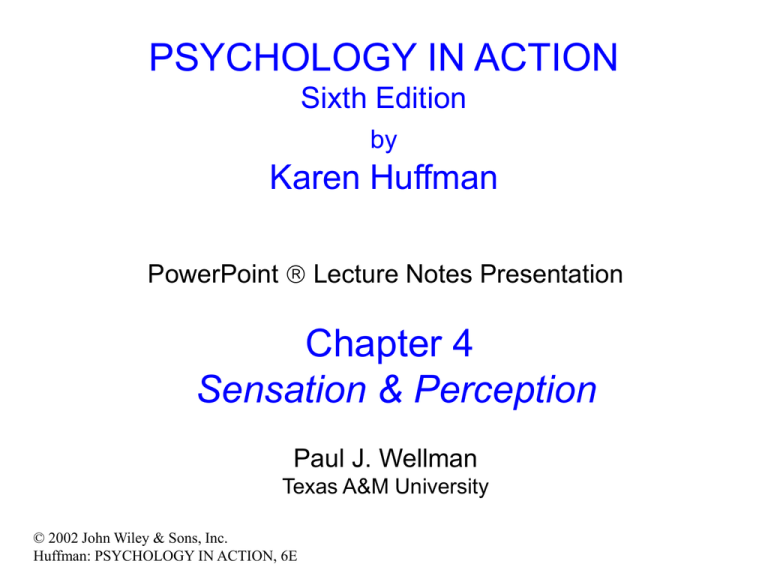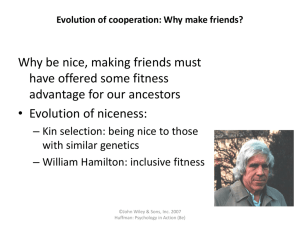
PSYCHOLOGY IN ACTION
Sixth Edition
by
Karen Huffman
PowerPoint Lecture Notes Presentation
Chapter 4
Sensation & Perception
Paul J. Wellman
Texas A&M University
© 2002 John Wiley & Sons, Inc.
Huffman: PSYCHOLOGY IN ACTION, 6E
Lecture Overview
•
•
•
•
Experiencing Sensations
Vision
Other Senses
Perception
– Selection
– Organization
– Interpretation
© 2002 John Wiley & Sons, Inc.
Huffman: PSYCHOLOGY IN ACTION, 6E
Sensation and Perception
• Sensation is the process of receiving,
converting, and transmitting information from the
outside world
– Sensory organs contain receptors that transduce
sensory energy into nerve impulses that are carried to
the brain
• Perception involves organization and
interpretation of sensory input
– Interpretation of sensory input is an active process
– Perceptions can differ among people
• Top-down processing versus bottom-up
processing
© 2002 John Wiley & Sons, Inc.
Huffman: PSYCHOLOGY IN ACTION, 6E
Sensation/Perception
• Transduction: sensory receptors convert
a physical energy into nerve impulses
© 2002 John Wiley & Sons, Inc.
Huffman: PSYCHOLOGY IN ACTION, 6E
Sensory Thresholds
• Each sensory system has a threshold level of
energy that is required to activate that sense
– Absolute threshold: The smallest amount of energy
that can be detected by a system
– Difference threshold: The smallest difference in
sensory energies that can be detected
• Different people can have widely varying
sensory thresholds
• Thresholds can change within a person over
time and as a function of hormone status
– Olfactory sensitivity during pregnancy
– Ability to taste foods as we get older
© 2002 John Wiley & Sons, Inc.
Huffman: PSYCHOLOGY IN ACTION, 6E
Modification of Sensation
• A key function of sensory systems is to detect
change within the environment
– Movement in the peripheral aspects of the eye may
signal food or danger
– Constant pressure of an object on the skin may not be
important
• A stimulus that moves across the skin may be a snake or a
spider
• The skin adapts to constant pressure
– Constant pain is unpleasant and wastes body
resources
• Pain is offset by a control system involving opiates
© 2002 John Wiley & Sons, Inc.
Huffman: PSYCHOLOGY IN ACTION, 6E
Vision
• External light falls on receptors within the
eye to generate the visual message
• Light = electromagnetic radiation
– Wavelength of light determines color
© 2002 John Wiley & Sons, Inc.
Huffman: PSYCHOLOGY IN ACTION, 6E
Anatomy of the Eye
© 2002 John Wiley & Sons, Inc.
Huffman: PSYCHOLOGY IN ACTION, 6E
Photoreceptors
• Photoreceptors are light-sensitive cells
found within the retina
– Rods are sensitive to light, but not color,
and are active under low-light conditions
– Cones are sensitive to color, are not active
in low-light conditions, and allow for fine
detail
– Rods and cones use different
photopigments that react to light so as to
generate nerve potentials
© 2002 John Wiley & Sons, Inc.
Huffman: PSYCHOLOGY IN ACTION, 6E
Retinal Photoreceptors
• Light passes through the
retinal layers to reach the
photoreceptors at the inner
retinal surface
• Photoreceptors and bipolar
cells conduct potentials to
the ganglion cells, which in
turn initiate action potentials
which are transmitted to the
thalamus
© 2002 John Wiley & Sons, Inc.
Huffman: PSYCHOLOGY IN ACTION, 6E
Sensory Coding
• Activation of retinal
cells by light results
in action potentials
that travel along
neurons that project
to the occipital cortex
© 2002 John Wiley & Sons, Inc.
Huffman: PSYCHOLOGY IN ACTION, 6E
Hearing
• Receptors within the ear are tuned to
detect sound waves (changes in sound
pressure level)
– Sound waves vary in terms of
• Frequency: corresponds to pitch
• Amplitude: corresponds to loudness
• Sound loudness is measured in
decibels
© 2002 John Wiley & Sons, Inc.
Huffman: PSYCHOLOGY IN ACTION, 6E
Sound Loudness (dB)
© 2002 John Wiley & Sons, Inc.
Huffman: PSYCHOLOGY IN ACTION, 6E
Anatomy of the Ear
(Sound Waves)
© 2002 John Wiley & Sons, Inc.
Huffman: PSYCHOLOGY IN ACTION, 6E
Pitch and Loudness
• Sound waves vibrate the basilar
membrane within the cochlea of the ear
– Hair cells containing receptors bend in
response to vibration of the membrane
– Hair cells trigger action potentials that are
carried to the auditory cortex
– Different frequencies produce maximal
vibration of different areas along the
membrane: produces place coding of pitch
© 2002 John Wiley & Sons, Inc.
Huffman: PSYCHOLOGY IN ACTION, 6E
Perception
• Perceptual processes
include
– Selection refers to choosing
which of many stimuli that will
be processed
– Organization involves
collecting the information into
some pattern
– Interpretation involves
understanding the pattern
• Perceptions can be in error
– Illusions are visual stimuli
that are misinterpreted
© 2002 John Wiley & Sons, Inc.
Huffman: PSYCHOLOGY IN ACTION, 6E
Horizontal-Vertical Illusion
WHICH LINE IS LONGER?
© 2002 John Wiley & Sons, Inc.
Huffman: PSYCHOLOGY IN ACTION, 6E
Form Perception
• Figure and background are basic
organizational themes for perception
• Gestalt psychologists examined
properties that make for a good figure
– Figure is perceived as distinct from the
background
– Figure is closer to the viewer than the
background
© 2002 John Wiley & Sons, Inc.
Huffman: PSYCHOLOGY IN ACTION, 6E
Gestalt Organizational Principles
© 2002 John Wiley & Sons, Inc.
Huffman: PSYCHOLOGY IN ACTION, 6E
Color Perception
• Humans are able to discriminate 7 million
different hues
• Colors convey important information
– Ripeness of food
– Danger signals (traffic lights; for some people…)
• Trichromatic theory
– Eye contains 3 different color sensitive elements
• Blue, green or red elements
• Trichromatic theory accounts for color mixing of lights
• Opponent-Process theory
– Visual system is organized into red-green, blueyellow and black-white units
• Theory can account for negative color afterimages
© 2002 John Wiley & Sons, Inc.
Huffman: PSYCHOLOGY IN ACTION, 6E
Extrasensory Perception
• ESP refers to the ability to perceive
stimuli that are outside the 5 senses
– Telepathy: the ability to read minds
– Clairvoyance: the ability to perceive objects
or events
– Precognition: the ability to predict the future
– Psychokinesis: the ability to move objects
© 2002 John Wiley & Sons, Inc.
Huffman: PSYCHOLOGY IN ACTION, 6E
Copyright
Copyright 2002 by John Wiley & Sons, Inc., New
York, NY. All rights reserved. No part of the material
protected by this copyright may be reproduced or
utilized in any form or by any means, electronic or
mechanical, including photocopying, recording, or by
any information storage and retrieval system, without
written permission of the copyright owner.
© 2002 John Wiley & Sons, Inc.
Huffman: PSYCHOLOGY IN ACTION, 6E





